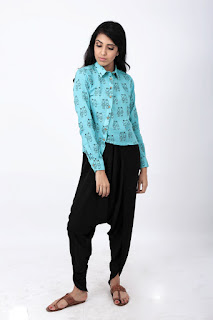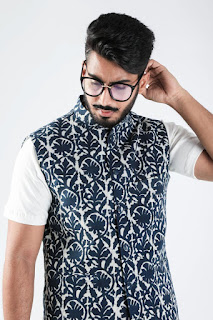The art of Indian block print fabric is a labor-intensive, painstaking
process that has survived from ancient times to the present because of
the beauty of the handmade products. Scraps of cloth found in the ruins
of Mohenjo Daro, an ancient city of the Indus Valley Civilization,
provide evidence that this type of fabric decoration was practiced in
India as long ago as 3000 BCE.
The process takes time, team work
and, especially, skill. The three main tools used by fabric printers are
wooden blocks, fabric and dye. It can take five carvers up to three
days to create an intricate design in a block of teak for use for
printing. The printers may use up to 30 blocks to complete a design.
The
process begins with the
wooden blocks. Wood carvers cut designs into
blocks of different shapes and sizes. The top has a handle for the
printers to grasp. Each one has two or three cylindrical holes through
it to permit the passage of air and to allow excess dye to squeeze out.
The
next step in the process is the arrangement of the fabric. Workers
stretch 24 layers of jute taut over a long rectangular table. The jute
serves as a pad to provide resiliency to the printing surface. The
workers secure the fabric to the jute pad with pins, keeping it tightly
in place.
When the printers are ready to do the printing, they
select from three approaches. In the first method, called discharge
printing, the printer dyes the fabric first. Then the printer chemically
removes the dye from the portions of the cloth which will take the
design. The bleached sections are treated and then dye is reapplied to
create the
block print design. In the second method, also known as
direct printing, the cloth is bleached, and then dyed whole.
Printing
is done from left to right. When the printer is using the discharge or
direct methods, the printer dips the block into the dye then presses it
onto the fabric. The printer slams the back of the wood hard with the
fist to create a clear impression.
As they work, the printers
pull a wooden cart bearing their tools along with them. The wooden
blocks can be interchanged from one piece of fabric to another, creating
different patterns.
Custom designs and different colors can be used
from one fabric to another, creating still more individual work.
Each
color of a design is done by a different printer, coming behind the one
before and repeating the process. The process requires teamwork, as
each subsequent printer must place the block on the fabric accurately to
create a beautiful, whole pattern.
Once the pattern is finished
on the whole length of fabric, the piece is treated to fix the dyes.
First, the fabric is dried in the sun. Once dried, the fabric is rolled
in newspapers and steamed in special boilers.






